PCM 1/32 Reggiane Re.2005
The Reggiane series of fighters - the Re.2000, Re.2001, Re.2002 and Re.2005 - were technically among the best Italian fighters designed during the Second World War. All the aircraft designed and produced were obviously based on the Seversky SEV-1 and P-35, unsurprising given that their designer Roberto Longhi had worked for Seversky during the period in which the SEV-1 was designed, before returning to Italy to take the position of Chief Designer at Reggiane. As a result, the Reggiane series of fighters were in many ways far in advance of those from other Italian companies. Unfortunately, the Re.2000 gained a bad reputation with its "wet" wing that continually leaked; despite the fact this was not used in any of the succeeding designs, the series suffered as a result, and was disliked by the leadership of the Regia Aeronautica, with the result that none were ever ordered in significant numbers.
The Italian Air Force suffered throughout the war from the fact that the Italian aviation industry had been unable to develop a really powerful engine for use in fighters. Performance of Italian fighters did not meet international standards until the German Daimler-Benz engines were adopted, beginning with the DB601, which powered the Re.2001 among others. These first fighters powered by the DB601 were basically limited modifications of designs that had been initially powered by Italian radial engines. Following the success of these designs, the industry was ordered to develop fighters that would specifically be powered by the DB605, to take full advantage of this powerful engine. The Fiat G.55, Macchi C.205V and Re.2005 were the designs that came out of this process.
Longhi began work on the Re.2005 Sagittario (Sagittarius, the Archer) in 1941, and completed the prototype in December 1941. This fighter differed considerably from its predecessors, with greater wingspan, and a longer, more finely-streamlined fuselage, as well as outwards-retracting landing gear which replaced the rearwards-retracting system used on the others. It also was more heavily armed, with an engine-mounted 20mm cannon, two wing-mounted 20mm cannon, and two fuselage-mounted 13.7mm machine guns. Unfortunately, the DB605 engine to power the prototype was lost by the Italian railroad system during delivery, and was only found some months later at a railroad station near Milan - this may have been the result of sabotage.
First flight took place May 7, 1942, and resulted in a wheels-up landing that inflicted little damage. By July 1942, in the official trials at Guidonia, the Re.2005 recorded to maximum speed of 421.6 mph at 22,802 feet, making it the fastest Italian fighter of the war. Amazingly, by the end of 1942 only three prototypes and one static-test airframe had been ordered while the Reggiane factory stood nearly idle; this was due to the successful flights of the G.55 and C.205, which had both taken place the month before that of the Re.2005 - the loss of the engine had been a substantial setback. While these aircraft were now the subjects of extensive production contracts, Reggiane was setting up to deliver 16 "zero series" aircraft to demonstrate their capability. Finally, in February 1943, 18 pre-production and 750 production Sagittarios were ordered.
While this was going on, the Luftwaffe had shown interest in testing the Re.2005, and had sent a specially-prepared DB605A and a VDM propeller to Reggiane, who mated these to the second prototype in April 1943. The German test pilot recorded a top speed of 447.4 mph at 23,950 feet, a performance superior to that of the P-51D, Spitfire XIV, and Bf-109G.
Sixteen "zero series" pre-production aircraft were delivered in May 1943, powered by German DB605A engines. The 18 pre-production aircraft that commenced delivery that June were powered by the Fiat RA 1050 RC Tifone, the license-built version of the DB605, which was unfortunately as poor a copy of the DB605 as the previous Italian attempt with the DB601 had been. The German-engined aircraft demonstrated superior performance with their more-reliable engines. Eleven of the these 18 were taken by the Germans after the Armistice in September 1943 and re-engined with DB605As with VDM props before being flown to an uncertain fate in Germany.
Ten of the "zero series" Re.2005s were delivered to 362nd Squadriglia of 22nd Gruppo in Naples in early June, 1943. On June 28, they were flown to Sigonella, Sicily, to oppose the Allied landings on the island. By the time they were withdrawn to the mainland four days later, only two of the Re.2005s were flyable. On July 31, 362nd Squadriglia received ten pre-production Re.2005s. By the time of the Armistice that September, only two Re.2005s were left, neither flyable. The squadron had recorded no victories during the period of its equipment with the new fighter. Squadron personnel burned to two survivors to prevent them falling into German hands.
The Re.2005 is proof that the Italian aviation industry was capable of designing and producing fighters that were the equal if not the superior of any used by their opponents.
Fortunately, the political-military leadership of fascism was so incompetent - as has ultimately been the case in every country that has taken the route of far right radicalism - that this achievement by the Italian aviation industry ended up meaning nothing.
This kit, the fourth injection-molded 1/32 kit from Pacific Coast Models, is the first kit of the Re.2005 done in this scale in injection plastic. I am told that at least one vacuform was released in this scale several years ago, but have no further knowledge of it. Regardless, this kit is now definitive for the scale.
The kit has been produced for Pacific Coast Models by Sword, and the difference in the box between this and the Macchis done before for PCM by MPM is obvious even before taking the parts out of their resealable plastic bags and cutting them off the sprues for test-fitting. The decision to end the relationship with MPM was ended over that company's decision to depart from the designs submitted by PCM for production of the Macchi C.202 and C.205 kits, which was why those kits had the faults they did. This kit has none of that.
The resin for the nicely-detailed cockpit and the wheel wells is crisp and very effective in the amount of detail that is there. I like that it is almost all molded-in detail, which will simplify construction while resulting in a good-looking cockpit.
Decals are provided for five aircraft: two flown by the Regia Aeronautica, one flown by the Aviazione Della Republicca, and two by the Luftwaffe. With the addition of side numbers and serial numbers on the sheet, a modeler could do any of the Re.2005s that saw the light of day. The decals are up to the usual standard of excellence one finds with PCM kits.
Being as simple as it is in kit design, the Re.2005 is a fast project. I assembled the fuselage before inserting the cockpit, once I determined there would not be the fit problems I had found with the Macchi kits (which were done by a different company). The only really difficult part of the who project was fitting the blast tubes for the fuselage-mounted machine guns in the gun panel. I needed to thin that past considerably with my Dremel getting the part thin around the gun troughs, then trim them out so the resin parts would fit. Some industrial-strength sanding and filing was needed to get that area of the nose smooth.
The resin wheel wells fit inside the wings easily once the block was taken off the top. I was careful to test-fit the wing to the fuselage several times, since the Re.2005 doesn't have wing dihedral and it would be easy to end up with anhedral if the upper wing-fuselage joint was not checked carefully. There was a gap in that joint on both sides that needed to be filled with cyanoacrylate glue before being covered with Mr. Surfacer and sanded smooth. All the main joints needed Mr. Surfacer to get a clean model. The centerline seam aft of the cockpit also needed filling with cyanoacrylate glue; this was easily done from the inside without the cockpit in place, and gave a strong joint to the structure there.
The Re.2005 had a very limited scheme - basically dark green over medium grey. I used Xtracrylix RAF Dark Green and RAF Medium Sea Grey for the colors, each lightened for a bit of “fading.” If one is historically accurate with this model, it is a clean airplane since they only had been in service a few months before seeing their sole week of combat in Sicily.
This Re.2005 kit is the essence of simplicity in production design. I don't think this fact lessens the ultimate result in the least, and for the modeler whose time is limited (as mine has become recently), having a simple project that looks good when completed is a Big Plus.
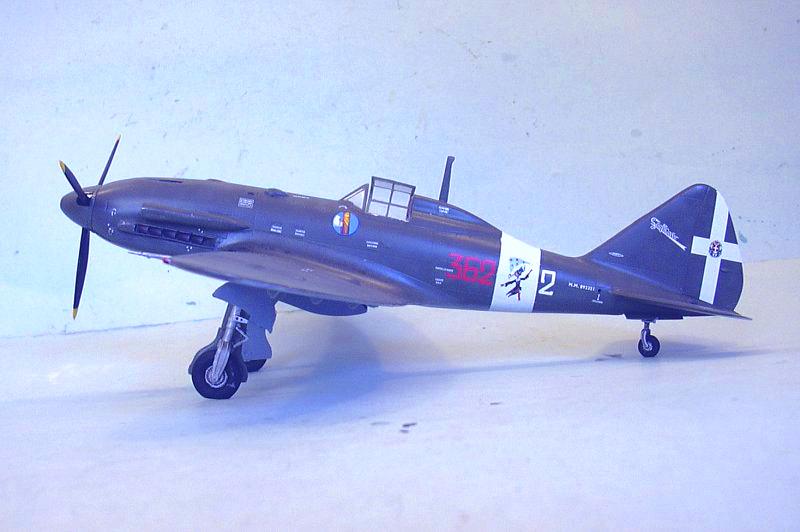
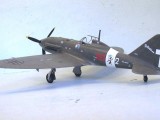
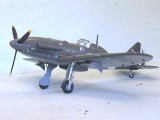
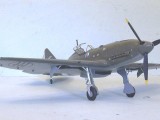
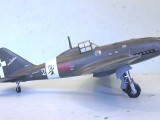
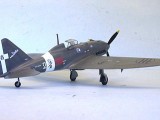
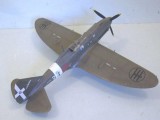
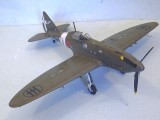
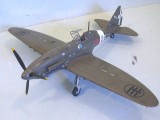
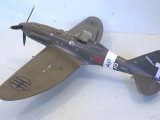
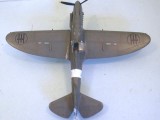
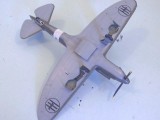
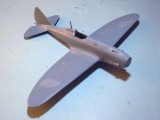
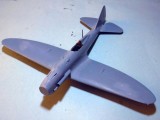

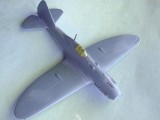
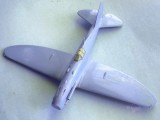

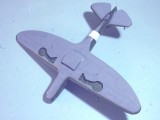
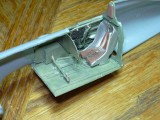
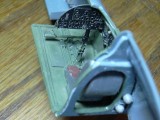
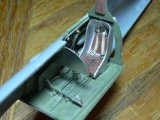
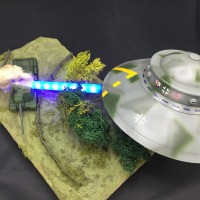
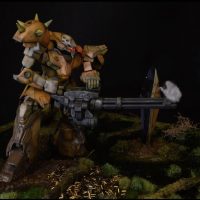
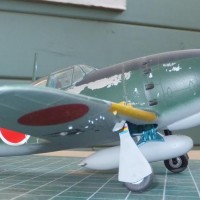
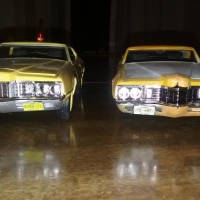
This is excellent.
I have always been a fan of Italian aircraft and since more than two decades I have a plan to build those three families of aircraft (Fiat G.50 - G.55 (OK, there's only two in that series), Re. 2000 - 2005 and Macchi 200 - 205). I haven't gotten there really but when I retire in 25 years or so I might find the time, until then I enjoy hoarding the required kits at least 🙂 !
As usual Tom, a good story and a good build!
BTW, we had the RE 2000 in the Swedish Air Force during WWII, calling it the J 20. In the 1980s when I learnt to fly there was a man at the flying club who had flown them. He said that they were very nice in the air but tricky to take-off and land and the engines were unreliable. According to the Italians one of the main reasons for the quality problems was that we flew them a lot, building lots of hours that the Italians (and other combatants) did not because theirs were shot down or written off long before ours. One is preserved at the Air Force Museum in Linköping.
Regards
Magnus
Interesting information on the J20, Magnus. Thanks for that.
Italy took the P-35 to a new level...one of graceful beauty, which you captured with your fine build.
Nice clean build, great narrative, very informative as always.
Tom,
Very nicely done and a great representation of the Regginiae
That is a beautiful model Tom, I really like the outcome!